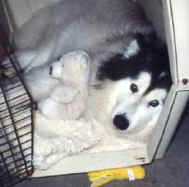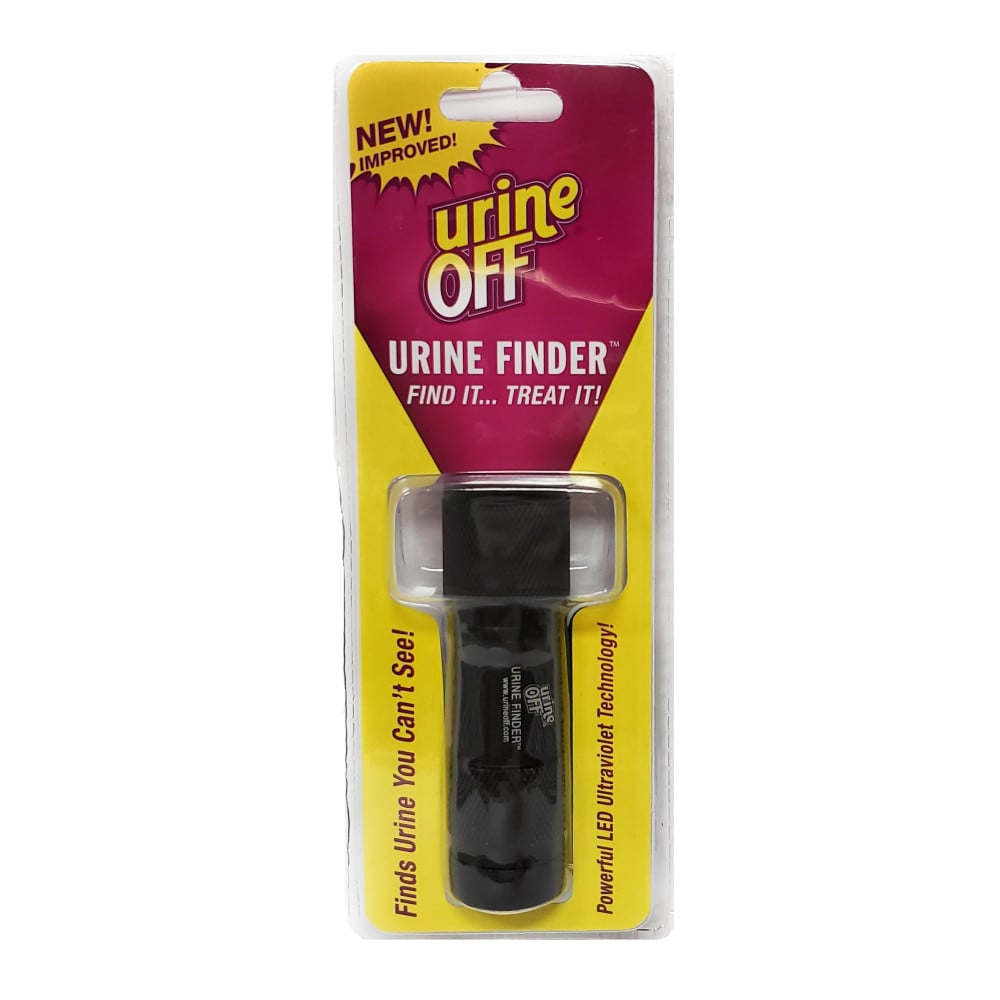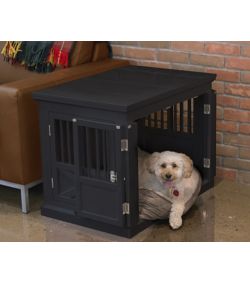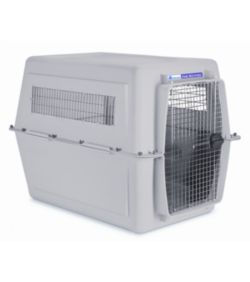 Crate
Training A Puppy
Crate
Training A Puppy
Crate training is the best gift you can give your new Malamute. There is a misconception that "cages" (also called "crates") are "cruel". However, it is only humans that associate them with cruelty - a dog doesn't think that way. As humans we are primates - a different species. We associate cages with confinement and zoos. However, to your dog it's his "cave", "den" or "bedroom". He feels safe and secure there and a natural place to be. It's a place he can go to relax and know that he will not be bothered. He can feel secure since it's a place he can easily defend (primitive canine thinking, yes, but your Malamute is a primitive dog!). The crate also spares him punishment for getting into trouble when you aren't home and he's too young to know the difference between right and wrong. Dogs instinctively do not urinate or defecate in their dens - so it is the perfect place for him to rest and wait for your return as he will heroically try to keep from having accidents where he "hangs out" and sleeps. Mom taught him that by keeping her whelping box very clean!
More good reasons to use a crate:
- A crate is convenient when you travel - often hotels will allow crated dogs in rooms when they would never allow loose dogs
- Crating gives your dog a sense of security when you're gone and can lessen separation anxiety.
- A crate is a good place to put your puppy or dog when they get on YOUR nerves! After one too many chewed up things it's nice to put them somewhere they can't get into any MORE trouble!
- A crate is a safe way for your dog to travel - it's like a doggie seatbelt. Many dogs lives have been saved by the crate in an accident.
- If you have multiple dogs, each can have their "own" space to collect special toys and it has "their" personal smell.
- It's somewhere safe to put the dog when visitors come over that are afraid of dogs - or if the dog doesn't like the company!
- It's a place a dog with children can get a break from their constant pestering. (Assuming the parents have taught the children good dog skills - to leave the dog alone when it's in the crate).
- It's great for housebreaking! A crate trained dog often learns quicker and is more reliable in the house.
More information on the types of crates available
Housebreaking and crate training are done at the same time.You will use the crate to help with potty-training and it's also beneficial for teaching the "house rules". It's not fair to expect a young puppy to understand the rules so the crate helps keep him out of trouble while he's learning. It should NEVER be used as a punishment tool. You can, however, put the pup/dog in the crate when they make you so angry you might lose control! It's better to crate than to lose your temper AND lose your dog's respect in the process!
A 8-10 week old puppy will need to relieve himself once at least every two hours at first until he begins to be capable of more control. He will also need to go out about 10-20 minutes after play or a meal. No puppy wants to soil where he sleeps. You'll want to purchase a "large" or "extra large" dog crate. Wire crates are easier to store and usually give the dog a bit more room, but dogs usually prefer the "airline" type plastic crates because they are more cave like. However, if your pup is a voracious chewer, the metal ones might be better. Plastic contains an escape artist better (at least in our experience!). An adult dog should be able to stand, turn around and lie down comfortably in the crate you buy (of course, a puppy will soon grow to take up all that extra space so buy an adult-sized crate - not a puppy sized one). However, if the crate is adult sized (which is ok) and the puppy is having accidents in it, you'll want to temporarily divide it (with boards, chicken wire, etc), to give him just enough room to stand, turn around and lie down. Do not leave food or water IN the crate for him. Don't leave his food out so he can feed freely, as his need to eliminate will be in relation to when he is fed. He will need to go out shortly after each feeding and at least every 2-3 hours in between too. At bedtime withhold food and water after 8:00 p.m. At 11:00 p.m. take him out one last time. Put puppy in his crate with his toys but NO food or water. If possible, place the crate in your bedroom (he'll feel more secure being near you). Only take him out if you suspect the nighttime crying is to go potty. If you feel he is crying JUST to get out, be strong, or he will learn screaming and crying to get out will get him what he wants and you might end up with an obnoxious brat (Shadow learned this trick-ugh!).
Never keep the pup's collar on in the crate. Have it nearby to slip on if you need to take him outside, but not in the crate. Dogs have strangled when they've gotten caught on something and panicked - particularly dangerous are choke-type collars (which should only be used during training class anyway). In the morning CARRY the puppy to the spot you want to be the "bathroom" (if you only take him as far as the back porch, that's where he'll learn to go). Set him down. When he finally goes, praise profusely. Then play, feed and water. Pay attention to the signals that say he needs to go out again after eating. If he begins to circle, sniff the floor, whine, or get that uncomfortable look (usually about 20 minutes after eating or drinking, and immediately after active play) - he has to go out. After anticipating his needs correctly several he will begin to get the idea and ask in his own way. Some puppies stand by a certain door, some paw the door, some whine, some bark, some come to you and "look" you in the eye to get you to read their minds. Each puppy will develop his own way of asking so be aware and look for his signal.
Expect accidents even if you are judiciously consistent in your training. If you see an "accident" in progress, a surprise scruff shake and stern "NO!" is very effective. DO NOT punish an accident you didn't see happen! The puppy will only become confused. DO NOT "rub his nose" in it that's just cruel and teaches him it's ok to be dirty. It's your praise when he asks and goes in the correct place that potty trains a puppy.
Only return him to his crate when you can't watch him closely. If you follow this routine you will painlessly teach your puppy to be housebroken. Most important point here is that no correction is allowed if it's YOUR fault and you left the puppy too long without a chance to go out, even if he didn't ask. In that case YOU get the scruff shake!
Crate training can help you train a puppy, but do not OVERUSE it. If you work and the puppy will be alone for long periods it would be unfair to keep him confined the entire time and at bedtime too. In this case it's best to keep the puppy in a small, confined and safe area at bedtime or when you go out. Potty training will not go as quickly since the puppy has no one available to help him learn by taking him outside immediately. He will not be as compelled to "hold it' since he is able to move away from the accident. Although a Malamute puppy will go to great lengths to avoid soiling himself, he will not consider your carpet as sacred. Accidents on carpets or floors are best removed by a Malamute stain and odor remover that contains ENZYMES (Nature's Recipe or Four Paws Professional Stain and Odor Remover work well). It will remove the desire for the puppy to return to the same place again and again.
Housebreaking Older Dogs
It's more difficult to housebreak an older dog but NOT impossible. First you must clean all the old urine spots with an enzyme cleaner to get rid of as much smell as possible (don't use ammonia to clean - it smells similar to the ammonia in urine to a dog). Then, whenever your adult dog is in the house with you "tether" him to your body. In other words, attach his 6 foot leash and him to your belt so he has to follow you EVERYWHERE in the house. After a short time you'll notice a certain "look" or body posture he gets when he is evenTHINKING of marking. You immediately correct with a "uh oh NO! potty's!"as soon as you see the "look" or posture. If he pees anyway, he gets the chewing out of his life. If he resists the urge, give a calm, not too excited "good boy" . Immediately take him outside the preferred "potty spot" and let him urinate there with more praise. You may have to do this for several weeks with an older dog - and he may, once given "freedom", backslide. That is NORMAL. If he does you go back to the tether. Give himhis house freedom in small doses - just the living room or kitchen at first, if that's where you are at. You will have to be vigilant and paying attention to catch him "thinking" BEFORE he marks. If you can't tether for some reason, he needs to be outside or in the crate. It works. It takes persistence and cooperation between everyone in the household (sometimes a child will notice that "look" even before you do! and can definitely say NO! to the dog).NEVER punish a dog for something you don't see happen right then. You CAN show it to him, grunt and sniff disapprovingly, but no hitting, no scolding, and no punishment. (I'll show them the spot I'm cleaning and go "oh, what's this...arrgh, a bad dog did this, grrrrr" as I'm cleaning it up. He knows it's his smell, but if you didn't catch him "in the act" you should not punish or he won't know what he did wrong.) You must catch him thinking of doing it, or in the act.
If you wish to crate train a dog that has never been crate trained for other reasons - such as staying in a hotel, confining the dog when company is over, etc. the best way is to leave the open crate in an accessible place. Give yourself and the dog plenty of time to get used to the idea. (Don't expect to start crate training Thursday for a weekend vacation!). Feed your dog in the crate at meals.If he goes in to "check it out" toss in a cookie as a reward. You want to make the crate a great place to hang out. Put some of his favorite toys in there. Don't leave water or food (other than the tossed cookie) in there however. Once he's comfortable going in and out, close the door for short periods. Some dogs will HATE this and throw a fit. It's best to ignore the fit and pretend you don't hear it. Be matter of fact (no sympathy allowed!). On the other hand there are SOME that just never do like the crate. We've had a couple of girls that are fine with the door open - even hang out there because they feel like it - but close the door and they scream like banshees! A person only has so much patience too, so if it gets THAT bad, and you've given it a good long try, you need to come up with other options - perhaps a utility room or bare bedroom would be a better place to confine a true crate-hater (and most dogs are not). If that is not an option (perhaps the dog is too destructive) then you might want to contact your vet for medication to help desensitize the dog and help him overcome his fear or phobia. There are also natural products on the market that have a calming effect that may help.
A crate is a tool. It can be very helpful in getting your puppy or newly adopted adult off to a good start. It can also be overused or used as a substitute for teaching the puppy house manners and good behavior. He needs to know what you want. He needs to know the rules. If you are having problems it is wise to find a good obedience class or instructor (that uses positive methods - no punishing, no jerking around and LOTS of treats) to help you learn to teach your dog properly. Crate training is not a substitute for your attentiveness and consistency, but can help you supervise and create an environment where you can feel success and your dog accomplishment. It can make him a better Malamute!
More information & Helpful links...
American Dog Trainers Network link










